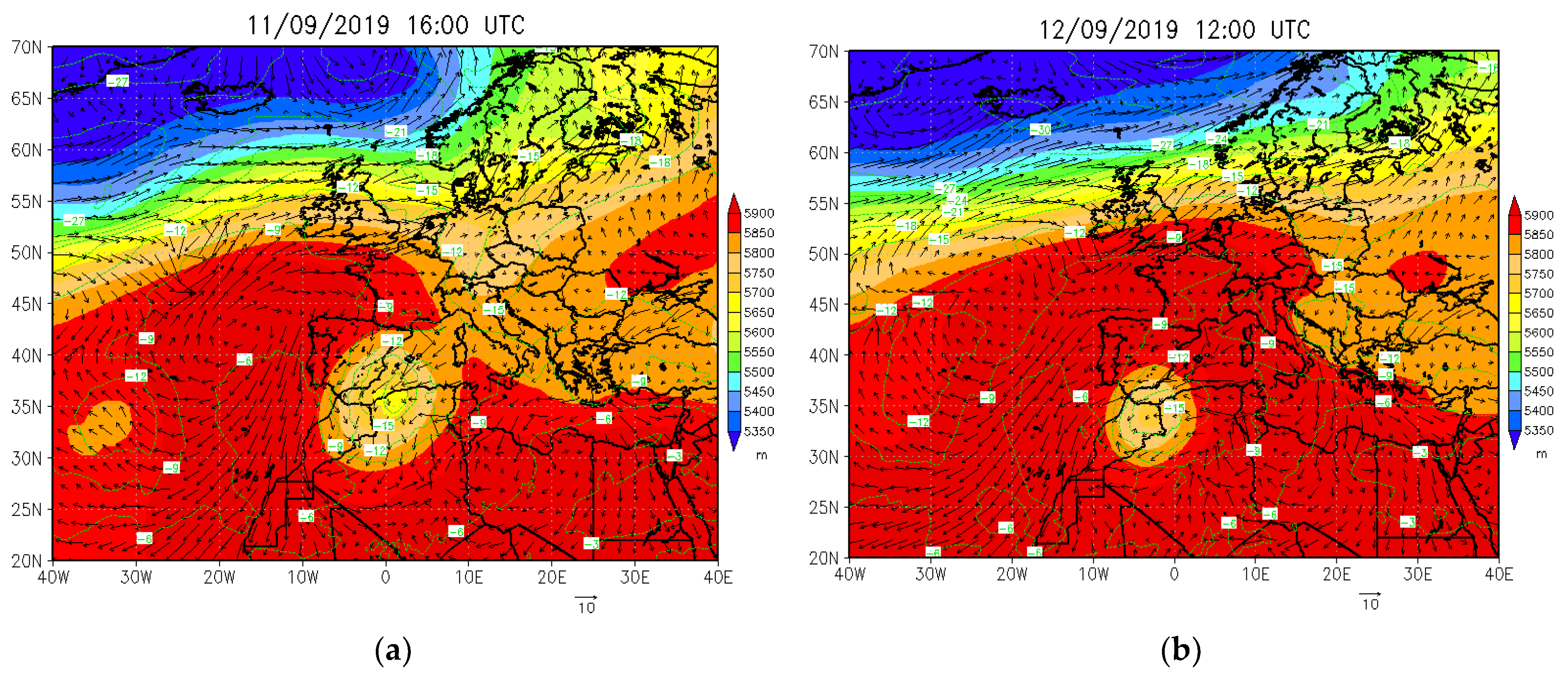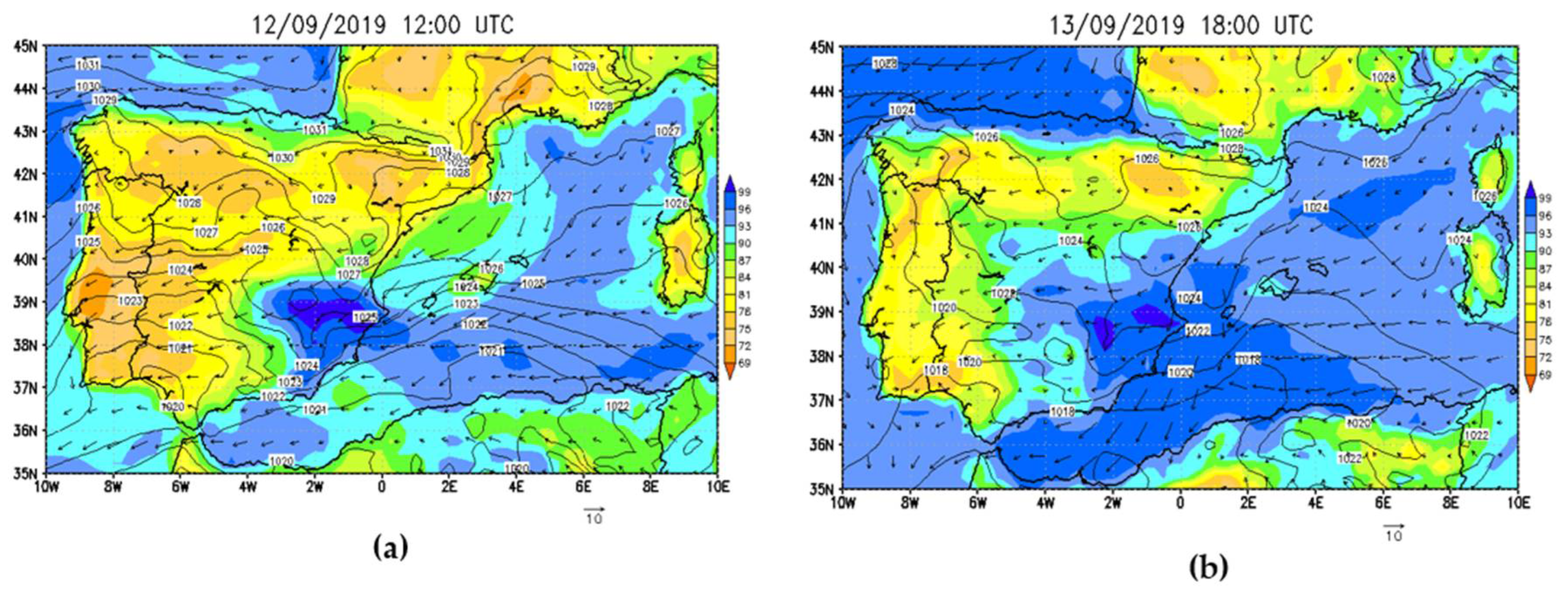The September 2019 Flash Flood Event in Eastern Spain: Synoptic Analysis and Extreme Rainfall Assessment †
Abstract
:1. Introduction
2. Materials and Methods
3. Results
4. Discussion
Author Contributions
Funding
Institutional Review Board Statement
Informed Consent Statement
Data Availability Statement
Conflicts of Interest
References
- Martín-Vide, J.; Moreno-García, M.C.; López-Bustins, J.A. Synoptic causes of torrential rainfall in South-eastern Spain (1941–2017). Geophys. Res. Lett. 2021, 47, 143–162. [Google Scholar] [CrossRef]
- Gómez, I.; Pastor, F.; Estrela, M.J. Sensitivity of a mesoscale model to different convective parameterization schemes in a heavy rain event. NHESS 2011, 11, 343–357. [Google Scholar] [CrossRef]
- Pastor, F.; Valiente, J.A.; Estrela, M.J. Sea surface temperature y torrential rains in the Valencia region: Modelling the role of recharge areas. NHESS 2015, 15, 1677–1693. [Google Scholar] [CrossRef]
- Peñarrocha, D.; Estrela, M.J.; Millán, M. Classification of daily rainfall patterns in a Mediterranean area with extreme inten- sity levels: The Valencia region. Int. J. Climatol. 2002, 22, 677–695. [Google Scholar] [CrossRef]
- Tapiador, F.J.; Marcos, C.; Sancho, J.M.; Santos, C.; Núñez, J.Á.; Navarro, A.; Adler, R.F. The September 2019 floods in Spain: An example of the utility of satellite data for the analysis of extreme hydrometeorological events. Atmos. Res. 2021, 257, 105588. [Google Scholar] [CrossRef]
- Olcina, J. Incremento de episodios de inundación por lluvias de intensidad horaria en el sector central del litoral mediterra- neo español: Análisis de tendencias en Alicante. Sémata 2017, 29, 143–163. (In Spanish) [Google Scholar] [CrossRef]
- Núñez-Mora, J.Á. Histórico temporal de lluvias en el sureste de la Península, 11 al 15 de septiembre de 2019. Rev. Tiempo Y Clim. 2019, 5, 1. (In Spanish) [Google Scholar]
- Hillebrand, F.L.; Bremer, U.F.; Arigony-Neto, J.; da Rosa, C.N.; Mendes, C.W., Jr.; Costi, J.; de Freitas, M.W.D.; Schardong, F. Comparison between atmospheric reanalysis models ERA5 and ERA-Interim at the North Antarctic Peninsula region. AAG/A 2021, 111, 1147–1159. [Google Scholar] [CrossRef]
- Gómez, I.; Niclòs, R.; Estrela, M.J.; Caselles, V.; Barberà, M.J. Simulation of extreme heat events over the Valencia coastal region: Sensitivity to initial conditions y boundary layer parameterizations. Atmos. Res. 2019, 218, 315–334. [Google Scholar] [CrossRef]
- Millán, M.; Estrela, M.J.; Caselles, V. Torrential precipitations on the Spanish east coast: The role of the Mediterranean sea surface temperature. Atmos. Res. 1995, 36, 1–16. [Google Scholar] [CrossRef]
- Pastor, F.; Estrela, M.J.; Peñarrocha, D.; Millán, M.M. Torrential rains on the Spanish Mediterranean coast: Modeling the effects of the sea surface temperature. J. Appl. Meteorol. Climatol. 2001, 40, 1180–1195. [Google Scholar] [CrossRef]
- Millán, M.M.; Estrela, M.J.; Miró, J.Y. Rainfall components: Variability y spatial distribution in a Medi terranean Area (Valencia Region). J. Clim. 2005, 18, 2682–2705. [Google Scholar] [CrossRef]




| PRECIPITACIÓN ACUMULADA | ||||
|---|---|---|---|---|
| 11/09/2019 | 12/09/2019 | 13/09/2019 | 14/09/2019 | |
| Crevillente | 0 | 114.3 | 10.15 | 12.59 |
| Catral | 0 | 193.5 | 16.66 | 19.6 |
| Orihuela | 0 | 154.8 | 119.4 | 6.23 |
| Villena | 11.94 | 23.48 | 8.95 | 8.16 |
| Villajoyosa | 19.5 | 23.68 | 4.18 | 20.7 |
| El Pilar | 0 | 112.7 | 132.5 | 1.39 |
| Yecla | 5.34 | 31.23 | 10.19 | 17.95 |
| Abanilla | 11.94 | 23.48 | 8.95 | 0 |
| Mula | 6.4 | 79.5 | 8.3 | 9.8 |
| La Ribera | 0 | 66.2 | 158.8 | 4.1 |
| Torre Pacheco | 0 | 127.2 | 109 | 3.6 |
| Cieza | 1 | 94.1 | 91.23 | 9.7 |
Publisher’s Note: MDPI stays neutral with regard to jurisdictional claims in published maps and institutional affiliations. |
© 2022 by the authors. Licensee MDPI, Basel, Switzerland. This article is an open access article distributed under the terms and conditions of the Creative Commons Attribution (CC BY) license (https://creativecommons.org/licenses/by/4.0/).
Share and Cite
Hernández-Conesa, M.S.; Gómez, I.; Carballo-Lafuente, G. The September 2019 Flash Flood Event in Eastern Spain: Synoptic Analysis and Extreme Rainfall Assessment. Environ. Sci. Proc. 2022, 19, 54. https://doi.org/10.3390/ecas2022-12800
Hernández-Conesa MS, Gómez I, Carballo-Lafuente G. The September 2019 Flash Flood Event in Eastern Spain: Synoptic Analysis and Extreme Rainfall Assessment. Environmental Sciences Proceedings. 2022; 19(1):54. https://doi.org/10.3390/ecas2022-12800
Chicago/Turabian StyleHernández-Conesa, Maria Sol, Igor Gómez, and Guillermo Carballo-Lafuente. 2022. "The September 2019 Flash Flood Event in Eastern Spain: Synoptic Analysis and Extreme Rainfall Assessment" Environmental Sciences Proceedings 19, no. 1: 54. https://doi.org/10.3390/ecas2022-12800
APA StyleHernández-Conesa, M. S., Gómez, I., & Carballo-Lafuente, G. (2022). The September 2019 Flash Flood Event in Eastern Spain: Synoptic Analysis and Extreme Rainfall Assessment. Environmental Sciences Proceedings, 19(1), 54. https://doi.org/10.3390/ecas2022-12800






